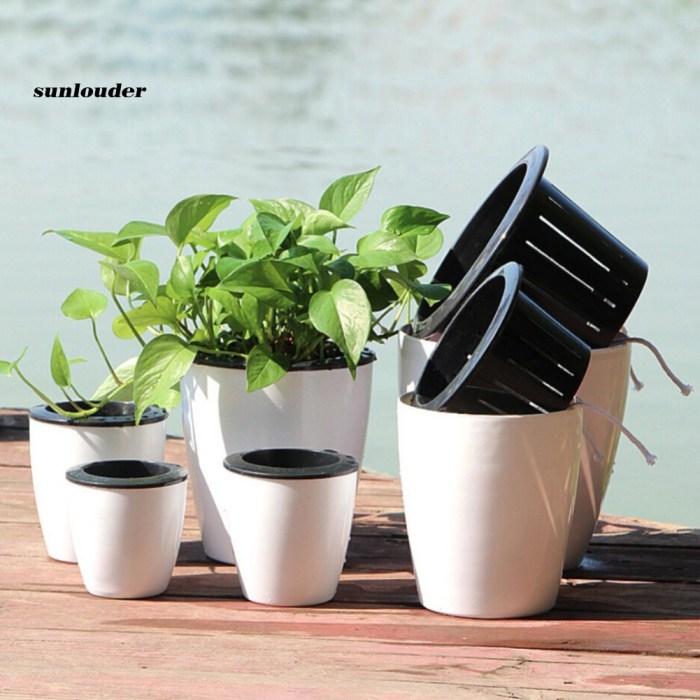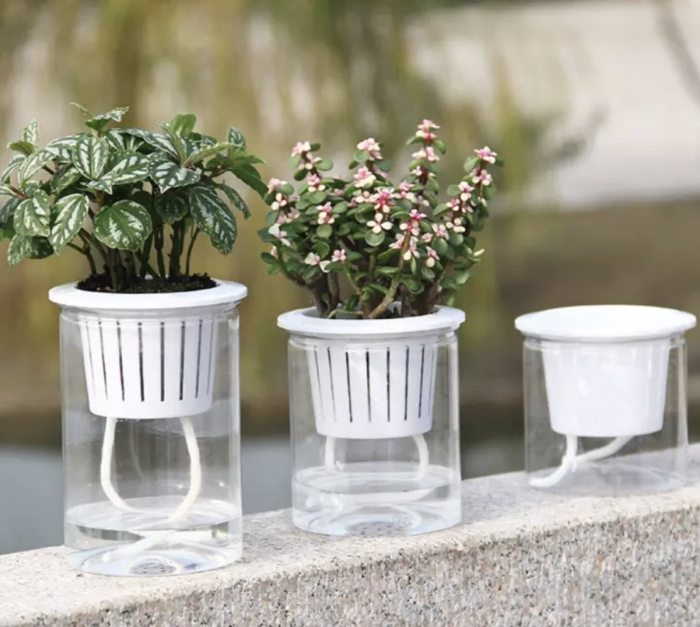Self watering indoor hanging planters – Self-watering indoor hanging planters offer a convenient and stylish solution for adding greenery to your home. These innovative planters use built-in self-watering systems to provide plants with the moisture they need, making them ideal for busy individuals or those who travel frequently.
With a variety of self-watering mechanisms, plant selection options, and design considerations to explore, this guide will provide you with all the information you need to create a thriving indoor oasis with self-watering hanging planters.
Self-Watering Mechanisms
Self-watering systems for indoor hanging planters offer a convenient and effective way to keep plants hydrated without the need for frequent manual watering. These systems utilize various mechanisms to deliver water to the plant’s roots, ensuring optimal growth and health.
Types of Self-Watering Systems
There are three primary types of self-watering systems commonly used in indoor hanging planters:
- Capillary Matting:This system involves placing a capillary mat, made of absorbent material such as felt or nylon, beneath the plant’s container. The mat wicks water from a reservoir below, providing a constant source of moisture to the plant’s roots.
- Wicking Systems:These systems use a wick, typically made of cotton or nylon, to draw water from a reservoir and deliver it directly to the plant’s roots. The wick acts as a conduit, transporting water from the reservoir to the plant’s root zone.
- Reservoir-Based Systems:These systems incorporate a reservoir that holds a supply of water. The reservoir is connected to the plant’s container via a tube or wick, allowing water to be drawn up into the container as needed. Reservoir-based systems offer greater control over watering frequency and can accommodate larger plants with higher water requirements.
Each type of self-watering system has its advantages and disadvantages: Capillary Matting:
Advantages
Low cost, easy to set up, suitable for small plants with low water requirements.
Disadvantages
Can be less effective in dry environments, requires frequent reservoir refilling. Wicking Systems:
Advantages
Efficient water delivery, minimizes water loss through evaporation, suitable for various plant sizes.
Disadvantages
Can clog over time, may require regular cleaning or replacement of the wick. Reservoir-Based Systems:
Advantages
Provides a large water reservoir, allows for extended watering intervals, suitable for larger plants with high water needs.
Disadvantages
More complex to set up, requires regular monitoring of water levels, can be bulky.
Self-watering indoor hanging planters offer a convenient and low-maintenance solution for adding greenery to your living space. These planters feature a reservoir that automatically waters the plants, making them ideal for busy individuals or those who travel frequently. Explore our extensive collection of hanging plants for living room that thrive in these self-watering planters, adding a touch of nature and style to your home décor.
Plant Selection for Self-Watering Planters

Selecting the right plants for self-watering hanging planters is crucial for their success. Consider factors such as water needs, growth habit, and root structure to ensure compatibility with the self-watering system.
Water Needs
Choose plants with moderate to low water requirements, as self-watering planters provide a constant supply of moisture. Avoid plants that require frequent watering or are prone to root rot.
Self watering indoor hanging planters are a great way to add greenery to your home without having to worry about watering them regularly. These planters come with a reservoir that holds water, which is then slowly released into the soil as needed.
This means that you can go away for a few days without having to worry about your plants wilting. If you’re looking for a low-maintenance way to add some life to your home, self watering indoor hanging planters are a great option.
You can find a wide variety of real indoor hanging plants that are perfect for these planters, so you’re sure to find one that fits your style. And because they’re self watering, you can enjoy your plants without having to worry about them dying from neglect.
Growth Habit, Self watering indoor hanging planters
Opt for plants with a compact or trailing growth habit that will complement the hanging planter. Avoid plants that grow too large or bushy, as they can become heavy and unstable.
Root Structure
Plants with shallow or fibrous root systems are well-suited for self-watering planters. Avoid plants with deep or invasive roots that may clog the reservoir or interfere with the watering mechanism.
Examples of Suitable Plants
- Spider plants ( Chlorophytum comosum)
- Pothos ( Epipremnum aureum)
- Snake plants ( Sansevieria trifasciata)
- ZZ plants ( Zamioculcas zamiifolia)
- Ferns (various species)
Design Considerations for Hanging Planters
Hanging planters are a beautiful and practical way to add greenery to any indoor space. They can be used to create a vertical garden, add a touch of color to a room, or simply bring the outdoors in. When choosing hanging planters, it is important to consider the aesthetic appeal, size, shape, and material of the planters.
Aesthetic Appeal
Hanging planters come in a wide variety of styles, from traditional to modern. The style of the planter should complement the décor of the room in which it will be hung. For example, a rustic planter would look great in a room with a farmhouse or cottage style, while a modern planter would be a better choice for a room with a more contemporary design.
Size and Shape
The size and shape of the hanging planter should be appropriate for the space in which it will be hung. A large planter will look out of place in a small room, while a small planter will get lost in a large room.
The shape of the planter should also be taken into consideration. A round planter will create a softer look, while a square or rectangular planter will create a more modern look.
Material
Hanging planters are made from a variety of materials, including metal, plastic, ceramic, and wood. The material of the planter should be durable and visually pleasing. Metal planters are durable and easy to clean, but they can be heavy. Plastic planters are lightweight and inexpensive, but they can be less durable than metal planters.
Ceramic planters are beautiful and durable, but they can be expensive. Wood planters are natural and rustic, but they can be more difficult to care for than other types of planters.
Installation and Maintenance of Self-Watering Planters

Self-watering hanging planters provide a convenient and efficient way to keep plants hydrated, even when you’re away. Here’s a comprehensive guide on how to install and maintain these innovative planters.
Installation
Installing self-watering hanging planters is a straightforward process:
- Choose a suitable location:Select a spot with ample sunlight and proper drainage.
- Assemble the planter:Follow the manufacturer’s instructions to assemble the planter, including the reservoir and drainage system.
- Fill the reservoir:Fill the reservoir with water according to the recommended level.
- Plant the plants:Dig a hole in the potting mix and carefully place the plant in it, filling in around the roots with soil.
- Hang the planter:Use a sturdy hook or bracket to hang the planter securely from the ceiling or wall.
Maintenance
Maintaining self-watering hanging planters is crucial for plant health:
- Watering:Monitor the water level in the reservoir regularly. Refill it as needed, especially during hot or dry weather.
- Fertilizing:Fertilize the plants according to the manufacturer’s recommendations, typically every 2-4 weeks.
- Pruning:Prune any dead or overgrown leaves or stems to promote healthy growth.
- Cleaning:Occasionally clean the planter and reservoir to prevent algae or mineral buildup.
Troubleshooting Common Issues

Self-watering hanging planters can occasionally experience problems, but with proper troubleshooting and maintenance, these issues can be resolved, ensuring the health and longevity of your plants.Common issues include overwatering, under-watering, and plant disease. Overwatering can lead to root rot, yellowing leaves, and stunted growth.
Under-watering can cause wilting, dry leaves, and eventual plant death. Plant disease can manifest in various forms, such as spots on leaves, wilting, or discoloration.
Self watering indoor hanging planters are a great way to add greenery to your home without having to worry about watering them regularly. They are especially well-suited for small trailing house plants , which can cascade down the sides of the planter and create a beautiful display.
These planters are available in a variety of styles and materials, so you can find one that fits your décor and needs.
Preventing and Resolving Issues
To prevent overwatering, ensure the reservoir is not overfilled and that the soil is well-draining. If overwatering occurs, allow the soil to dry out completely before watering again. To address under-watering, check the reservoir regularly and refill it when necessary.
If plant disease is suspected, isolate the affected plant and consult a plant care expert or refer to reputable online resources for specific treatment advice.Regular maintenance is crucial for preventing problems. Inspect plants regularly for signs of disease or pests.
Prune any dead or diseased leaves or stems to promote healthy growth. Clean the reservoir and refill it with fresh water periodically to prevent algae growth and maintain optimal water quality.
Last Point: Self Watering Indoor Hanging Planters
Whether you’re a seasoned plant enthusiast or a novice gardener, self-watering indoor hanging planters offer a low-maintenance and visually appealing way to bring nature indoors. By understanding the different types of systems, selecting suitable plants, and following proper installation and maintenance techniques, you can enjoy the beauty of lush greenery in your home without the hassle of frequent watering.
FAQ Guide
What are the benefits of using self-watering indoor hanging planters?
Self-watering indoor hanging planters offer several benefits, including reduced watering frequency, convenience, and improved plant health. They are ideal for busy individuals or those who travel frequently, as they provide a reliable source of moisture for plants.
How do I choose the right self-watering indoor hanging planter for my needs?
Consider the size and shape of the planter, the type of self-watering system, and the plants you intend to grow. Capillary matting systems are suitable for small plants with shallow roots, while wicking systems are better for larger plants with deeper roots.
Reservoir-based systems offer more water capacity and are ideal for plants with high water requirements.
What are some popular plants that thrive in self-watering hanging planters?
Many plants can thrive in self-watering hanging planters, including ferns, succulents, herbs, and flowering plants. Choose plants that are tolerant of moist conditions and have moderate water needs.